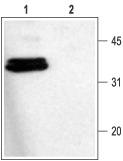Stx1a Rabbit Polyclonal Antibody
Other products for "Stx1a"
Specifications
| Product Data | |
| Applications | WB |
| Recommended Dilution | WB: 1:200-1:2000; IHC: 1:100-1:3000 |
| Reactivities | Mouse, Rat |
| Host | Rabbit |
| Clonality | Polyclonal |
| Immunogen | GST fusion protein with the residues 1-265 of rat syntaxin 1A . Intracellular, N-terminus. |
| Formulation | Lyophilized. Concentration before lyophilization ~0.8mg/ml (lot dependent, please refer to CoA along with shipment for actual concentration). Buffer before lyophilization: Phosphate buffered saline (PBS), pH 7.4, 1% BSA, 0.025% NaN3. |
| Purification | The antibody was affinity purified on immobilized syntaxin 1A fusion protein. |
| Conjugation | Unconjugated |
| Storage | Store at -20°C as received. |
| Stability | Stable for 12 months from date of receipt. |
| Gene Name | syntaxin 1A |
| Database Link | |
| Background | Syntaxin 1 is a member of the soluble N-ethylmaleimide-sensitive factor attachment protein receptor (SNARE) protein superfamily. The family includes 36 members in humans and is characterized by the SNARE motif, an evolutionarily conserved stretch of 60–70 amino acids that are arranged in heptad repeats. SNARE proteins are involved in exocytosis and intracellular vesicle trafficking and are essential for cell growth, hormone secretion and neurotransmission, processes that require rapid, targeted, and regulated membrane fusion. SNAREs can be roughly divided into vesicular (v-SNAREs) and target (t-SNAREs) based on their distribution on the transport vesicle or target membrane respectively. Thus, assembly of cognate v-/t-SNAREs between two opposing membranes generates trans-SNARE complexes, which bring the lipid bilayers in close proximity and drive membrane fusion. Syntaxin 1, like most SNAREs, is a type IV membrane protein with a relatively large N-terminus containing the SNARE motif located in the cytoplasmic side and a transmembrane domain located close to the C-terminus that functions as an anchor. Syntaxin 1 has been extensively studied for its role on neuronal and neuroendocrine cell exocytosis where it functions as the plasma membrane protein t-SNARE, which together with the vesicular v-SNARE protein VAMP and the membrane-associated SNAP-25 (synaptosome-associated protein 25 kDa), forms a trimeric, four-helical complex, which drives fusion of the two opposing bilayers. Syntaxin 1 together with SNAP-25 is the target of the neurotoxin botulinum neurotoxin type C (BoNT/C) which following proteolytic degradation of the proteins causes inhibition of neurotransmitter release . |
| Synonyms | HPC-1; p35-1; STX1 |
| Reference Data | |
Documents
| Product Manuals |
| FAQs |
{0} Product Review(s)
0 Product Review(s)
Submit review
Be the first one to submit a review
Product Citations
*Delivery time may vary from web posted schedule. Occasional delays may occur due to unforeseen
complexities in the preparation of your product. International customers may expect an additional 1-2 weeks
in shipping.






























































































































































































































































 Germany
Germany
 Japan
Japan
 United Kingdom
United Kingdom
 China
China



